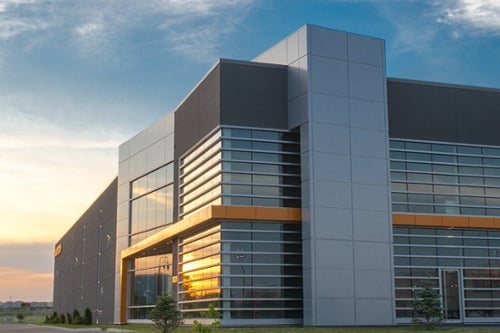Dan Bider is a busy rack specialist and Technical Director at Damotech, a company whose mission is to safeguard pallet racking systems across North America. We caught up with him between two surveys to chat about storage systems and how we can start thinking of their maintenance for the long term.
 In the business of assessing and repairing damaged racks for 21 years, he has worked for Damotech since 2006. Dan conducts large-scale rack surveys, trains installers and dealers throughout our network, and teaches current and new warehouse inspectors at OSHA. He is very familiar with racking.
In the business of assessing and repairing damaged racks for 21 years, he has worked for Damotech since 2006. Dan conducts large-scale rack surveys, trains installers and dealers throughout our network, and teaches current and new warehouse inspectors at OSHA. He is very familiar with racking.
Most days, he's on the road, traveling from one warehouse to another.
This interview was edited for length and clarity.
Dan, can you explain a little about racks and the context in which you operate?
Sure. Doing business often requires the storage of materials and products. To save space and store merchandise effectively, we can use racking systems. They allow for better use of vertical space and easy access to stocked materials.
Racks have one basic job; they support loads. That's the long and short of it. But they do it all differently. Some use 3" columns, while others need 4". Some are single columns in the front and back, while others are doubled-up. Horizontal braces can be closer together in configuration or further apart, depending on the rack manufacturer. The gauge of the steel can vary, as well as the rack's style and color. They can be rolled form or structural. These aspects talk to the rack's ability to support the weight.
So, can you simply buy racks and build a system to store pallets and be done with it?
That would be nice, but the reality is that all racks are engineered structures and should be approached as such. Shelving racks are not one-size-fits-all. Instead, they are designed and engineered to support "X" amount of weight based on the customer's needs. The manufacturer will use the variables I mentioned earlier to achieve this goal. This is why not any rack will do and why planning is necessary.
How, then, can you know the weight capacity of a system without an engineer looking at your racks?
The short answer is that you can't. Rack owners need to know the load capacity of their systems, and only an engineer or the rack manufacturer can establish the load capacity of the rack system. In the design process, many factors are considered: The space, condition, and composition of the floor, location of installation - are you located in a seismic zone, are seismic footplates required? Then, what are the types of loads placed on the system? Rack manufacturers take all of this into consideration when designing the rack systems and provide the owner of the new rack with LARCs (Load Application and Configuration Drawings).
Sounds complicated.
It may seem complicated, but let's go back to the main reason why we need racks in the first place. You might think that frames are just used to support products and/or raw materials, which is true. However, when you get to the core of things, racks are designed to hold your company's profits! The raw material that will eventually be turned into a product or the finished product awaiting shipment will be sold, and you will make a profit from it for your business. So, at the end of the day, it could be argued that pallet racks support your profits.
Are you suggesting viewing racking as an investment in your business?
Yes. Like most other investments, you have options to achieve your goals. Some options will cost you more money than others but will also bring you more benefits. So, you must decide the best way to go for your situation. If you are in business for the long haul or view safety as a priority, then a long-term strategy is in order. The bigger the company, the larger the warehouse becomes, and more shifts are needed to operate it. This translates into a lot of moving parts, which may create opportunities for impact and friction between forklifts and the racks, causing damage to the systems.
Some think rack damage is just part of doing business. What do you think of that?
You can consider rack damage as part of doing business, sure. However, it doesn't mean that steps cannot be taken to minimize the impacts and thus elongate the life of your storage racks and improve safety in your workplace. The safety and well-being of workers are imperative and should not be overlooked.
What do you say to people who see racking as a commodity?
Yes, racks typically are regarded as a commodity and an operating cost, not necessarily an investment. As a means to an end, if you will. As such, the impacts these racks take from forklifts tend to accumulate and weaken the rack structure, which can become hazardous. Due to its constant activity, I've always considered a warehouse to be like a living entity. In it, things are continuously changing as people and products are continually moving around. Therefore, it stands to reason that racks will get impacted by forklifts, possibly frequently. It would also stand to reason that if there were a way to address this issue on a more permanent basis, thinking of racks for the long term and preventing damage, it would be welcomed.
How does one think of racks for the long term? Can you give us an example?
Let's take the shipping and receiving area of a warehouse as an example. This is a place where there is plenty of activity, where forklifts come and go. Over the years, assessing warehouses for rack damage, I've noticed that these areas are more likely to see damage to racks and building columns from impacts. These areas are more likely to weigh heavily on your maintenance budget as racks need more maintenance. Over time, these expenses quickly add up to money that could have been spent elsewhere. When I survey and take a closer look at the damage, I see that, in most instances, the damage generally occurs at the base of the rack. Look up in the rack, and typically, the rack is fine. So, the critical area of concern becomes the bottom of the frames.
OK, so what should be done?
Prevention. Preventing future damage... If we think of a warehouse as a living entity, we know that impacts are forthcoming, which means you will be spending money on repairs now and in the future with no end in sight. The good news is that there is a solution. The damaged rack can be repaired with a permanent solution that will also protect the upright against future damage. Think of high-traffic areas where rack damage is continually occurring, such as the end of aisles. Those are the areas you can address first.
Is this what you mean by long-term, installing permanent solutions instead of continually replacing the damaged parts?
Yes. The concept of rack repairs is not new; however, for some, the idea of a lifetime warrantied rack repair may just be. Here's what I suggest to customers: Try a few repair kits and see how the product works in your warehouse. Everything else you have tried in the past brings you back to the same results? Try something different, even on a small scale, and offer yourself the possibility of obtaining different results. Results that will unavoidably save you money while, at the same time, increasing your warehouse safety. Applying the right solutions will cause your racks to last longer and become a longer-term investment. After all, isn't that good business practice?
Definitely. Dan, what advice would you give warehouse managers and operators who are concerned about rack safety in their warehouse? Where should they start?
Here are ways of approaching rack safety in the long term:
1. Make sure your pallet racks are fit for your requirements.
2. Don't exceed their load capacity. Have up-to-date calculations and communicate them to workers to prevent your racks from being overloaded, which could lead to damage or collapse.
3. Safeguard your racks like you would protect valuable new machinery or investment.
4. When planning new rack systems and evaluating your space, plan for wider aisles to give your forklift operators enough room to maneuver.
5. Enlist the help of experts to identify hazards near or within your racking systems and consider the issues – what is causing damage – and be proactive in preventing them.
6. Regular maintenance and good housekeeping: repair and replace damaged or missing components before they weaken your racking systems.
7. This is going to sound obvious but try to eliminate potential hazards. Maintain a clutter-free floor, and keep aisles clear, with a well-lit environment for your lift operators.
8. Have your pallet racks inspected regularly by a professional to ensure their safety and integrity.
9. Train your employees and make them aware of issues surrounding pallet rack safety.
Finally, investing in rack safety makes good business sense. Not only will you protect your workers, but also extend the life of your warehouse's storage systems and material handling equipment, as well as reduce the loss of inventory due to rack damage.













